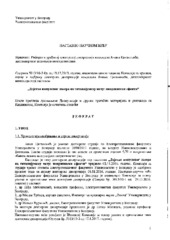Dejstvo impulsnog lasera na titanijumsku metu: površinski efekti
Action of pulsed lasers on titanium target: surface effects
| dc.contributor.advisor | Matavulj, Petar | |
| dc.contributor.other | Mihailović, Peđa | |
| dc.contributor.other | Stašić, Jelena | |
| dc.contributor.other | Momčilović, Miloš | |
| dc.contributor.other | Cvetić, Jovan | |
| dc.creator | Ciganović, Jovan | |
| dc.date.accessioned | 2020-08-06T10:44:32Z | |
| dc.date.available | 2020-08-06T10:44:32Z | |
| dc.date.issued | 2020-03-12 | |
| dc.identifier.uri | http://eteze.bg.ac.rs/application/showtheses?thesesId=7472 | |
| dc.identifier.uri | https://fedorabg.bg.ac.rs/fedora/get/o:22318/bdef:Content/download | |
| dc.identifier.uri | http://vbs.rs/scripts/cobiss?command=DISPLAY&base=70036&RID=17100809 | |
| dc.identifier.uri | https://nardus.mpn.gov.rs/handle/123456789/17274 | |
| dc.description.abstract | Interakcija lasera sa metalima proučava se decenijama, a posebno je intenzivirana u poslednje vreme, usled razvoja novih, efikasnih impulsnih lasera. Istraživanja u ovoj tezi su fokusirana na titanijum, koji poseduje niz odličnih osobina, što ga čini primenljivim u različitim savremenim tehnologijama. Obrada i procesiranje titanijuma mogući su različitim tehnikama, a primena lasera daje poseban kvalitet, poput visoke preciznosti obrade ili dobijanja specifičnih struktura na površini koje nije moguće generisati drugim metodama. Cilj ove doktorske disertacije je eksperimentalna optimizacija površinskog modifikovanja titanijuma impulsnim nano-, piko-, i femto-sekundnim laserima. Kao izvori laserskog zračenja korišćeni su nanosekundni CO2 laser, pikosekundni Nd:YAG, i femtosekundni Ti:safirni laser. Poznato je da stepen površinske modifikacije mete zavisi od parametara laserskog zračenja (talasne dužine, dužine trajanja impulsa, energije impulsa, itd.), od geometrije fokusiranja, od stanja površine i apsorptivnosti mete, kao i od sredine u kojoj se interakcija odvija. U cilju nalaženja optimalnih uslova za površinsku modifikaciju titanijuma ispitan je uticaj pojednih parametara lasera, kao i uticaj ambijenta. Utvrđeno je da primenjeni intenziteti laserskog zračenja dovode do modifikacija površine mete, pri čemu impulsi različitog trajanja drugačije modifikuju titanijumsku metu. Nanosekundni i pikosekundni laseri dovode do difuznog karaktera oštećenja uz prisustvo termalnih efekata, dok korišćenje femtosekundnih impulsa rezultuje u bolje definisanim oblastima oštećenja. Pokazano je da promena sredine ozračivanja presudno utiče na hemijski sastav i morfologiju površine mete. | sr |
| dc.description.abstract | The interaction of lasers with metals has been studied for decades, and has been especially intensified lately, due to the development of new, efficient pulsed lasers. Research in this thesis is focused on titanium, which has a number of excellent properties, making it applicable in various modern technologies. Treatment and processing of titanium is possible with various techniques, and the application of lasers gives a special quality, such as high precision machining or obtaining specific structures on the surface which cannot be generated by other methods. The goal of this doctoral dissertation is the experimental optimization of surface processing of titanium by pulsed nano-, pico-, and femto-second lasers. Laser radiation sources used were nanosecond CO2 laser, picosecond Nd:YAG, and femtosecond Ti: sapphire laser. It is known that the degree of surface modification of the target depends on laser radiation parameters (wavelength, pulse duration, pulse energy, etc.), focus geometry, the state of the surface and the absorption of the target, as well as from the environment in which the interaction takes place. In order to find the optimal conditions for surface modification of titanium, the influence of certain laser parameters, as well as the influence of the ambient, was examined. It has been found that the applied laser radiation intensities lead to the modification of the target surface, and that the pulses of different duration modify the titanium target in various way. Nanosecond and picosecond lasers lead to a diffuse character of damaged area with the presence of thermal effects, while the use of femtosecond pulses results in better defined area of damage. It has been shown that the change in the ambient of the irradiation affects the chemical composition and morphology of the target surface. | en |
| dc.format | application/pdf | |
| dc.language | sr | |
| dc.publisher | Универзитет у Београду, Електротехнички факултет | sr |
| dc.relation | info:eu-repo/grantAgreement/MESTD/Integrated and Interdisciplinary Research (IIR or III)/45016/RS// | |
| dc.relation | info:eu-repo/grantAgreement/MESTD/Basic Research (BR or ON)/172019/RS// | |
| dc.rights | openAccess | en |
| dc.rights.uri | https://creativecommons.org/licenses/by-nc-nd/4.0/ | |
| dc.source | Универзитет у Београду | sr |
| dc.subject | Interakcija sa nanosekundnim | sr |
| dc.subject | Interaction with nanosecond | en |
| dc.subject | titanium | en |
| dc.subject | titanijum | sr |
| dc.subject | modifikacija površine | sr |
| dc.subject | picosecond and femtosecond laser | en |
| dc.subject | surface modification | en |
| dc.subject | pikosekundnim | sr |
| dc.subject | femtosekundnim laserom | sr |
| dc.title | Dejstvo impulsnog lasera na titanijumsku metu: površinski efekti | sr |
| dc.title.alternative | Action of pulsed lasers on titanium target: surface effects | en |
| dc.type | doctoralThesis | en |
| dc.rights.license | BY-NC-ND | |
| dc.identifier.fulltext | https://nardus.mpn.gov.rs/bitstream/id/64318/Disertacija.pdf | |
| dc.identifier.fulltext | https://nardus.mpn.gov.rs/bitstream/id/64319/IzvestajKomisije22884.pdf | |
| dc.identifier.rcub | https://hdl.handle.net/21.15107/rcub_nardus_17274 |



